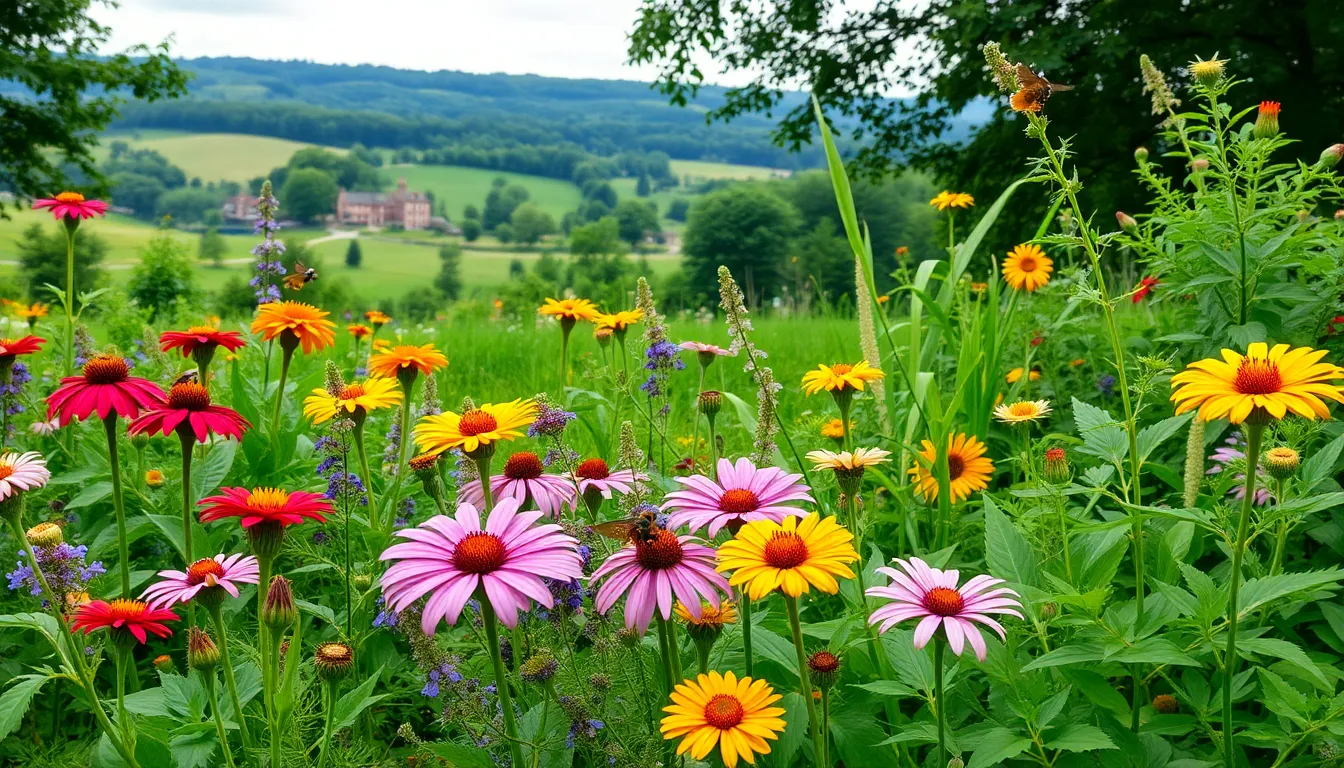When it comes to gardening, native Pennsylvania plants are like that friend who always shows up to the party with snacks—reliable, low-maintenance, and ready to impress. These local flora not only thrive in the Keystone State’s diverse climates but also provide essential habitats for wildlife. By choosing native plants, gardeners can create stunning landscapes while giving Mother Nature a high-five.
Imagine a garden bursting with vibrant colors, buzzing bees, and chirping birds, all while requiring less water and fewer chemicals. Sounds like a dream, right? It’s time to ditch the exotic divas that demand constant attention and embrace the hard-working, eco-friendly natives that know how to party in Pennsylvania. Whether you’re a seasoned gardener or just starting, native plants are the ultimate sidekick for a thriving outdoor space.
Native Pennsylvania Plants
Native Pennsylvania plants play a vital role in local ecosystems. These species are adapted to the region’s specific climate and soil conditions, which helps them thrive without excessive care. Not only do they offer aesthetic value, they also provide essential habitats for local wildlife, including pollinators like bees and butterflies.
A diverse range of native plants exists across Pennsylvania, including wildflowers, shrubs, and trees. For instance, the Eastern Redbud and Purple Coneflower are popular choices among gardeners. These selections support various wildlife, offering food and shelter for birds and beneficial insects.
Gardening with native plants leads to increased biodiversity. Such gardens can sustain local wildlife populations, which contribute to a balanced ecosystem. Moreover, native plants often require fewer resources, reducing the need for fertilizers and pesticides.
Highlighting their environmental benefits, native plants also improve soil health and water retention. These plants play a significant role in preventing erosion, particularly in areas with slopes or waterways. Choosing native species enhances resilience in landscapes while promoting ecological stability.
For those looking to incorporate native plants, resources are readily available. Organizations such as the Pennsylvania Native Plant Society provide valuable information and assistance. Finding appropriate plants for specific growing conditions can ensure successful cultivation and maintenance.
Native Pennsylvania plants represent a sustainable solution for creating vibrant, low-maintenance gardens. Embracing these species fosters environmental responsibility while adding beauty to outdoor spaces.
Importance of Native Plants

Native Pennsylvania plants hold immense value for both the environment and cultural heritage. They support local ecosystems while enhancing gardens’ beauty and functionality.
Ecological Benefits
Ecological contributions from native plants include attracting essential pollinators like bees and butterflies. They supply food and habitat for diverse wildlife species, creating balanced environments. Soil health improves significantly with native plants, as their root systems increase nutrient availability and resilience. Water retention capabilities further enhance local habitats, reducing the risk of erosion in vulnerable areas. By requiring fewer resources, native plants also lower the reliance on chemical fertilizers and pesticides, promoting sustainable gardening practices.
Cultural Significance
Culturally, native plants represent a connection to Pennsylvania’s historical landscapes. Many local communities utilize these plants in traditional practices and landscapes, preserving local identity. Additionally, native flora provides educational opportunities for schools and organizations about indigenous ecosystems. Artists and gardeners alike draw inspiration from their unique beauty, fostering appreciation for nature. Enhancing connections to heritage and environment, these plants play a vital role in celebrating Pennsylvania’s biodiversity and ecological history.
Popular Native Pennsylvania Plants
Native Pennsylvania plants offer a rich diversity for local gardening. They contribute to vibrant landscapes while supporting wildlife.
Trees and Shrubs
Eastern Redbud thrives in local environments, known for its pink flowers and heart-shaped leaves. Dogwood, another popular choice, provides stunning blooms and attracts various pollinators. Shadbush, or Serviceberry, produces edible berries that benefit both birds and humans. White Oak and Eastern Hemlock also play crucial roles, offering essential shade and habitat. These trees and shrubs not only enhance aesthetic appeal but also create diverse ecosystems.
Wildflowers
Purple Coneflower stands out with its striking petals and resilience, attracting beneficial insects. Black-eyed Susan’s bright yellow flowers enhance gardens while providing nectar for pollinators. A diverse selection of wildflowers, like Wild Bergamot and Butterfly Weed, supports a variety of wildlife. These plants thrive in different soil types, making them ideal for native gardens. Integrating wildflowers into landscapes encourages pollinator health and biodiversity.
Grasses and Ferns
Switchgrass flourishes in Pennsylvania’s soils, known for its height and unique structure. Little Bluestem features fine texture and color variations, promoting visual interest in gardens. Native ferns, such as Christmas Fern, add lush greenery and thrive in shade. These grasses and ferns stabilize soil, prevent erosion, and enhance habitat diversity. They provide essential cover and food for wildlife while requiring minimal resources for maintenance.
How to Incorporate Native Plants in Your Garden
Incorporating native Pennsylvania plants into a garden enhances biodiversity and supports local ecosystems. Selecting the right plants and employing smart design strategies make this process effective and enjoyable.
Choosing the Right Plants
Identify plants that thrive in the local climate. Consider Eastern Redbud for its beautiful blooms and shade provision. Opt for Purple Coneflower to attract pollinators like bees and butterflies. Evaluate soil conditions and sunlight exposure to make informed selections. Resources from the Pennsylvania Native Plant Society offer valuable guidance on suitable flora. Leverage this information to create a vibrant and diverse ecosystem.
Design Tips for Native Plant Gardens
Plan for varied heights and textures to create visual interest. Group plants in clusters to mimic natural growth patterns. Use native grasses like Switchgrass to stabilize soil and prevent erosion. Incorporate pathways or seating areas for accessibility and aesthetics. Maintain an open layout to ensure plants receive adequate sunlight. Implement mulching to retain moisture and suppress weeds. Implementing these design tips creates a harmonious space that invites wildlife while celebrating Pennsylvania’s natural beauty.
Challenges and Considerations
Choosing native Pennsylvania plants comes with challenges that gardeners should address. Invasive species pose significant threats to native ecosystems. These species compete for resources like sunlight, water, and nutrients, often outpacing local flora. Examples include Japanese Knotweed and Garlic Mustard. Controlling these invaders requires consistent management strategies that prioritize the health of native plants.
Climate adaptation demands careful consideration. Native plants are generally well-suited to their local climates, yet they may face challenges due to shifting weather patterns. Changes in temperature and precipitation can impact plant growth and survival. Selecting species that exhibit resilience to these changes becomes essential. Incorporating native plants known for their adaptability, such as the Eastern Redbud, ensures better chances of thriving in changing conditions. Local gardeners should continually assess and adjust their plant selections in response to evolving climatic factors.
Conclusion
Embracing native Pennsylvania plants is a powerful step toward sustainable gardening. These plants not only enhance the beauty of landscapes but also play a crucial role in supporting local ecosystems. By choosing native species, gardeners contribute to biodiversity while minimizing their environmental impact.
The connection to Pennsylvania’s rich cultural and ecological history further enriches the gardening experience. As communities cultivate these plants, they foster a deeper appreciation for their natural surroundings.
Ultimately, incorporating native plants into gardens is an investment in both the environment and the community, creating vibrant spaces that thrive with life.

